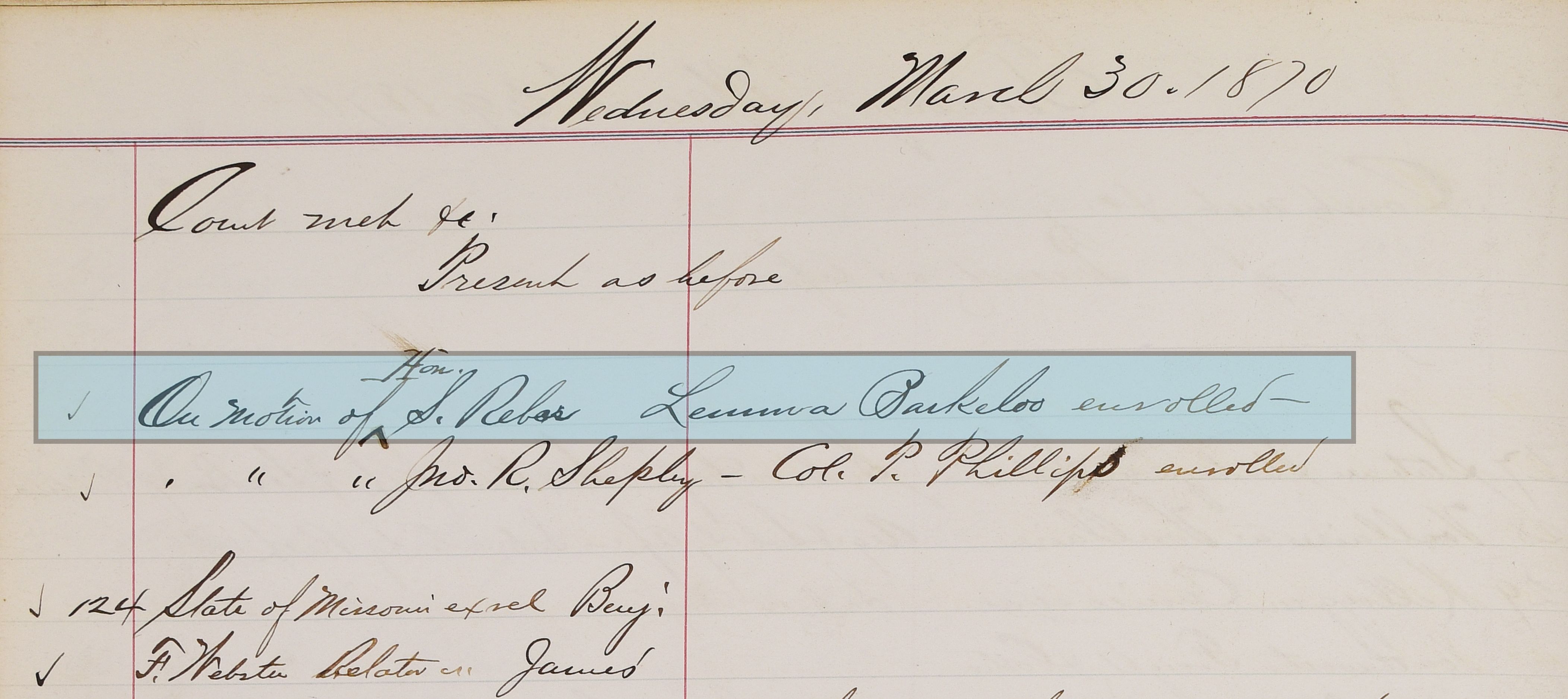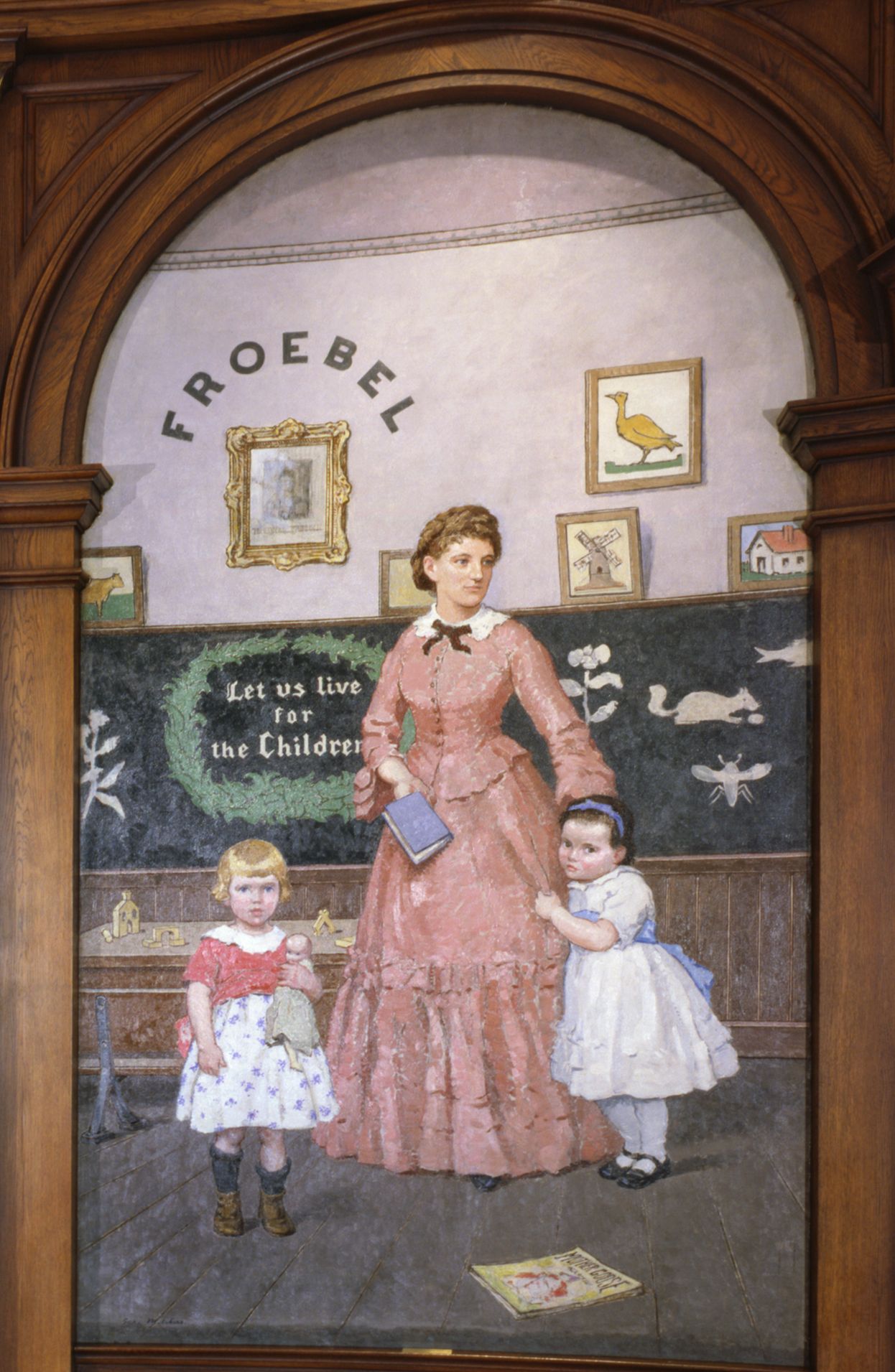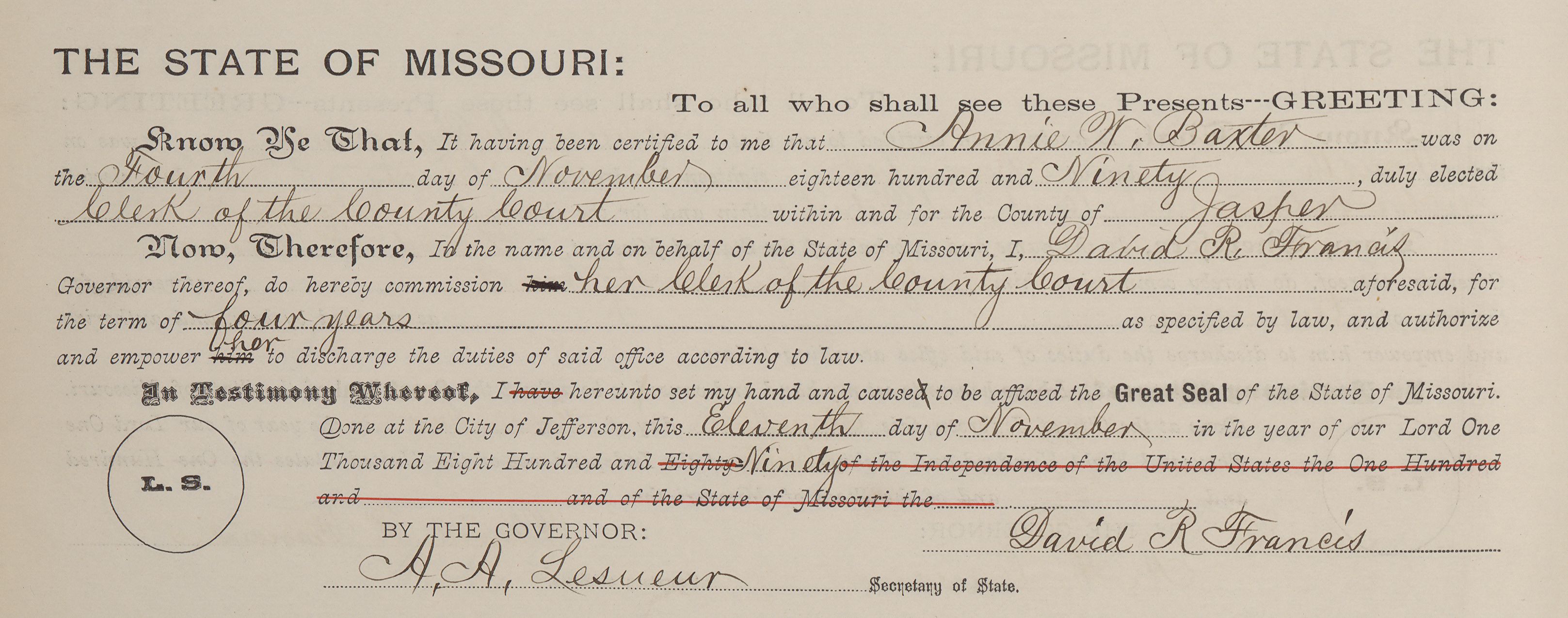| 1870 |
Missouri was the 21st state to ratify the Fifteenth Amendment to the U.S. Constitution prohibiting the federal government and each state from denying a citizen the right to vote based on that citizen's "race, color, or previous condition of servitude" on January 10, 1870. The amendment went into effect on March 30, 1870. |
| 1870 |
Lemma Barkeloo enrolled with the Supreme Court of Missouri on March 30, 1870 making her the first female lawyer in Missouri. She was also the first female trial lawyer in the United States and the first female lawyer to try a case in federal court, all in that same year. |

RG600, Supreme Court Minute Book, Lemma Barkeloo Admittance
|
| 1870 |
The First District Normal School (now Truman State University) was established in Kirksville as the state’s first public teacher’s college on March 19, 1870. The school had been founded in 1867 as a private institution. The Lincoln Institute Normal School was also established during this legislative session on February 14, 1870. |
| 1870 |
The Missouri School of Mines and Metallurgy (now Missouri University of Science and Technology), the first technological learning institution west of the Mississippi River, was established on February 24, 1870 by the General Assembly. Phelps County was approved as the location on December 20, 1870. |
| 1871 |
Warrensburg was selected as the location for the Second District Normal School and became known as Warrensburg Teachers College (now University of Central Missouri) on April 27, 1871. |
| 1871 |
Phoebe W. Couzins of St. Louis became Missouri's first female law school graduate when she graduated from the Washington University Law Department on May 8, 1871. Couzins later was appointed the nation's first female U.S. Marshal in 1887. |
| 1872 |
Gov. B. Gratz Brown and his family moved into the newly completed Governor’s Mansion on January 20, 1872. |
| 1873 |
Missouri’s Third District Normal School known as Southeast Missouri State Normal School (now Southeast Missouri State University) was established on March 22, 1873 in Cape Girardeau. |
| 1873 |
After petitioning the St. Louis School Board for the opportunity, Susan Elizabeth Blow opened the first public kindergarten in the United States at the Des Peres School in Carondelet on September 1, 1873. |

RG395, Missouri State Capitol Commission, Susan Elizabeth Blow Mural Located in Governor's Office
|
| 1874 |
The Eads Bridge, spanning the Mississippi River, opened in St. Louis on July 4, 1874. It was the first bridge across the Mississippi River south of the Missouri River. An elephant crossed the bridge on June 14, 1874 to test the strength of the new structure. |
| 1875 |
The decision in Minor v. Happersett was handed down by the U.S. Supreme Court on March 29, 1875. Virginia Minor, a cofounder of the Woman Suffrage Association of Missouri, attempted to register to vote in October 1872 for the upcoming Presidential election. The court decided the U.S. Constitution did not grant “all persons” the right to vote. Because it allowed states to determine voter eligibility, the case was subsequently used as a basis to disenfranchise voters for decades. |
| 1875 |
A grasshopper plague in the Midwest caused an estimated $15 million damage in Missouri in 1875. During the height of the plague, farmers said the Rocky Mountain Locusts would “block out the sun” and Missouri offered a bounty for bushels of the insects. |
| 1875 |
Missouri’s third Constitution was adopted on October 30, 1875. This Constitution removed the “Ironclad Oath” of the previous Constitution, as well as the other limitations towards former Confederates and Confederate sympathizers. It also limited taxation, extended the governor's term of office from two to four years, gave strong support to the principle of public education, and provided for the popular election of Supreme Court justices. |
| 1876 |
Known as the “Great Divorce,” the people of St. Louis voted to split St. Louis City and St. Louis County into different government entities on August 22, 1876. |
| 1881 |
Gov. Thomas Crittenden offered a $5,000 reward on July 28, 1881 for the arrest and conviction of members of the Jesse James gang. Robert Ford would shoot Jesse James killing him on April 3, 1882 in hopes of obtaining the award. |
| 1889 |
On May 10, 1889, three Bald Knobbers were executed in Christian County. Named from the grassy bald knob summits of the nearby Ozark Mountains, Bald Knobbers were a pro-Union vigilante group in southwest Missouri from around 1883-1889 and who opposed gang activities stemming from the anti-Bald Knobber bushwhackers ongoing since the Civil War. |
| 1890 |
Annie White Baxter was elected the county clerk of Jasper County on November 4, 1890. She was the first woman to hold elected office in Missouri and first female county clerk in the nation. |

RG5, Commissions, Register of Civil Officers Election, Annie White Baxter - Jasper County Clerk (1890)
|
| 1891 |
St. Louis’ Wainwright Building opened in 1891. One of America’s first skyscrapers, it was designed by Louis Sullivan. |
| 1892 |
Dr. Andrew Taylor Still founded the American School of Osteopathy in Kirksville on October 3, 1892 and had its first class of students. Osteopathy is a practice he invented where an individual relied on manipulation of joints and bones to diagnose and treat illness. |
| 1893 |
Walter Moran Farmer, the first Black attorney to graduate from Washington University-St. Louis, argued the case of Duncan vs. Missouri before the Missouri Supreme Court which was decided on May 30, 1893. He was the first Black attorney to argue before the court and was one of the first to argue before the United States Supreme Court where the case was appealed in 1894. |
| 1894 |
Union Station opened in St. Louis on September 1, 1894. At its opening, it was the world's largest and busiest railroad station and its train shed had the largest roof span in the world. |
| 1899 |
Scott Joplin's "The Maple Leaf Rag" was published in Sedalia, Missouri in 1899 with the copyright was registered on September 18, 1899. |